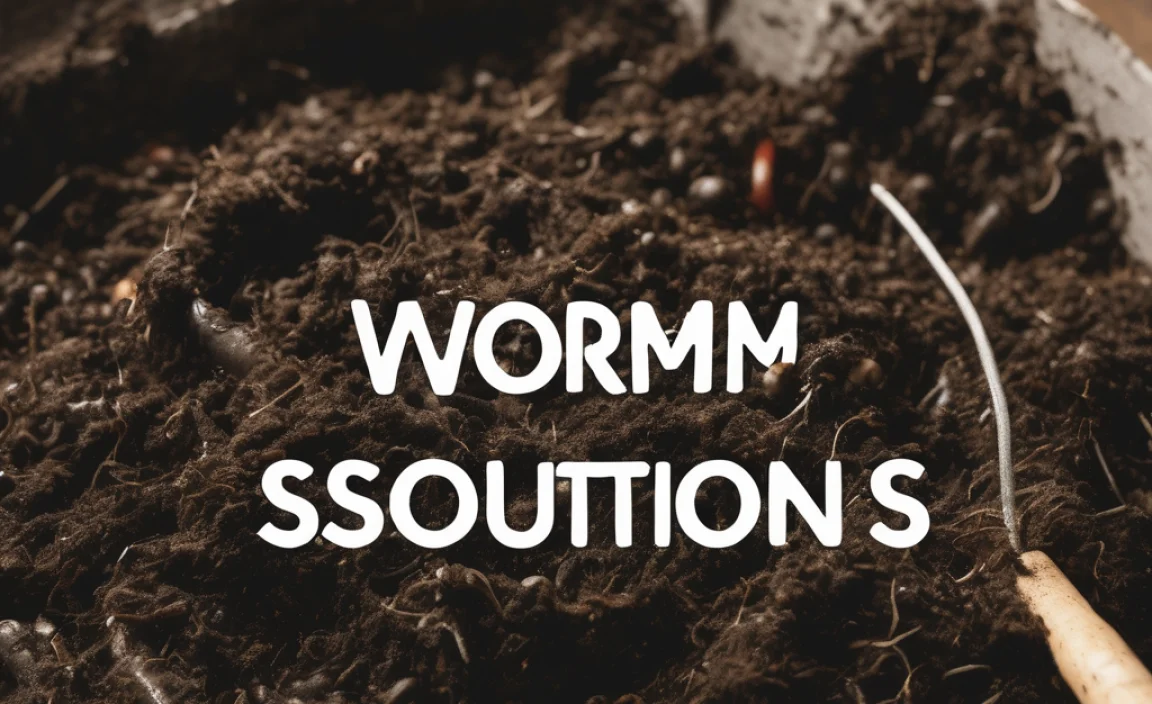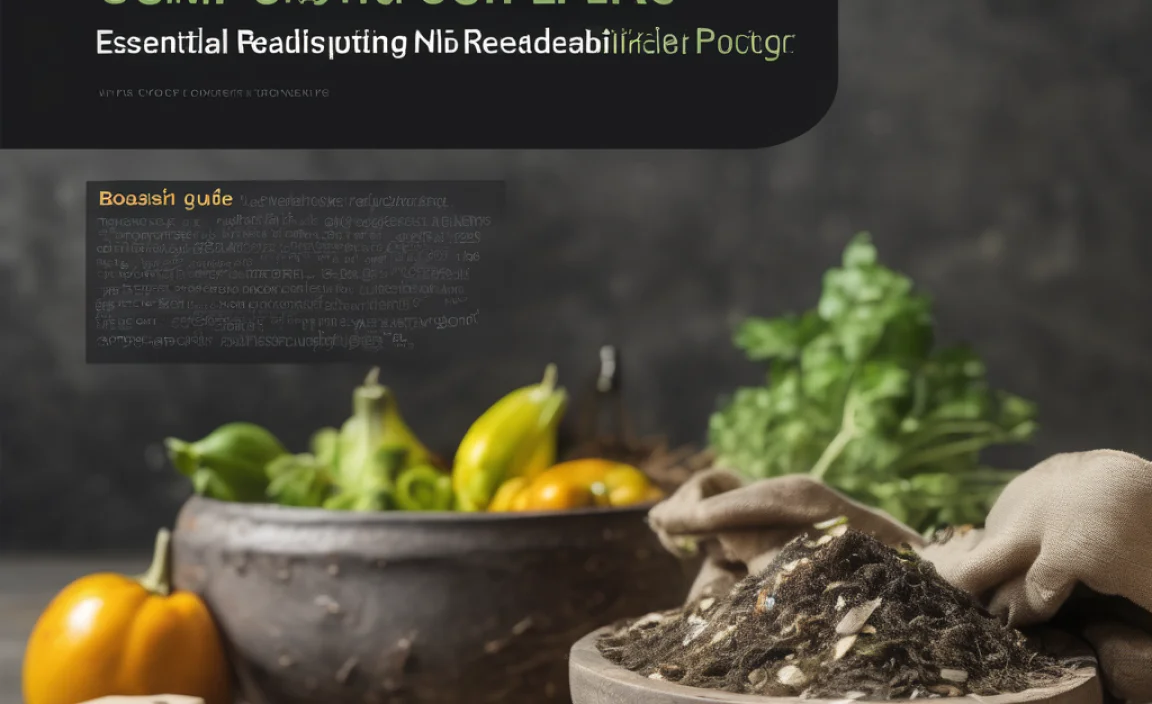Feeling a bit overwhelmed by all the climate change news? You’re not alone! Sometimes it feels like a huge problem, but what if I told you there’s a simple, super effective way to make a real difference right in your own backyard? It’s called composting, and in 2025, it’s more vital than ever. Let’s break down how this age-old practice is a powerful eco-fix for our changing planet. We’ll walk through it together, step-by-step, so you can start your own composting journey with confidence. Get ready to turn your kitchen scraps into garden gold!
Climate Change Composting Solutions 2025: Your Easy Eco-Fix is Here!
Hey everyone, Troy D Harn here from TopChooser! You know, I’ve been diving deep into the world of making our homes and gardens better, and one topic keeps popping up with serious importance: composting. Especially with climate change on everyone’s mind, composting isn’t just a nice-to-do for gardeners anymore. It’s becoming a truly impactful solution for 2025 and beyond. And the best part? It’s totally doable for anyone, whether you’ve got a sprawling garden or just a small balcony.
Think about it: our planet needs help. Landfills are overflowing, greenhouse gases are a major concern, and our soil can always use a boost. Composting tackles all of these issues directly. It diverts waste from landfills (which reduces methane, a potent greenhouse gas), creates nutrient-rich soil to help plants grow healthier and absorb more carbon, and it drastically cuts down on the need for synthetic fertilizers. It’s a win-win-win situation!
In this guide, I’m going to break down exactly what climate change composting solutions look like for 2025. We’ll cover the why, the what, and the how in simple terms. No fancy jargon, just practical advice to get you composting like a pro, easily and effectively. We’ll look at different methods, what you can compost, and how to make it work for your space, no matter how small.
Why Composting is a Climate Superpower
Let’s get down to brass tacks. How does turning your banana peels and coffee grounds into dark, earthy goodness actually help fight climate change?
- Reduces Landfill Waste: A massive chunk of what we throw away is organic material – food scraps, yard trimmings, paper. When this stuff sits in a landfill, it’s buried without oxygen. This anaerobic decomposition produces methane (CH4), a greenhouse gas much more potent than carbon dioxide (CO2) over the short term. By composting, you redirect this waste, preventing methane emissions.
- Improves Soil Health: Healthy soil is a carbon sink. When we compost, we create nutrient-rich humus. This humus improves soil structure, water retention, and aeration. Healthier soil means plants grow better, and healthy plants absorb more CO2 from the atmosphere as they grow.
- Decreases Reliance on Chemical Fertilizers: Manufacturing synthetic fertilizers is energy-intensive and often relies on fossil fuels. These fertilizers can also contribute to greenhouse gas emissions and water pollution. Compost provides natural nutrients, reducing the need for these manufactured products.
- Conserves Water: Compost acts like a sponge in your soil, holding onto moisture much longer. This means you’ll need to water your garden less, which is a significant benefit in many areas facing water scarcity.
So, when we talk about “Climate Change Composting Solutions 2025,” we’re really talking about recognizing composting as a powerful, accessible tool in our fight for a healthier planet. It’s a tangible way for each of us to contribute, starting today.
Getting Started: The Building Blocks of Your Compost Pile
The magic of composting happens when you create the right environment for tiny organisms – bacteria, fungi, worms, and other beneficial microbes – to break down organic materials. They’re the real heroes here, and we just need to give them what they need. Think of it like feeding your compost critters!
The two main ingredients you need to balance are “greens” and “browns.” It’s a simple concept that makes a huge difference in how well your compost breaks down.
Greens (Nitrogen-Rich Materials)
These are usually moist materials that provide nitrogen, which is food for the microbes. They tend to break down quickly.
- Fruit and vegetable scraps
- Coffee grounds and tea bags
- Grass clippings (in thin layers)
- Plant trimmings (non-woody)
- Eggshells
- Manure from herbivores (like rabbits, chickens, cows – avoid pet waste)
Browns (Carbon-Rich Materials)
These are usually dry, woody materials that provide carbon. They offer bulk and allow air to circulate, which is crucial for the microbes to breathe. They break down more slowly.
- Dry leaves
- Straw or hay
- Shredded newspaper (avoid glossy paper)
- Cardboard (torn into small pieces, remove tape/labels)
- Wood chips or sawdust (in moderation)
- Twigs and small branches (chopped up)
- Paper towel rolls and toilet paper rolls
A Good Rule of Thumb: Aim for a ratio of about 2 parts Browns to 1 part Greens by volume. Don’t stress about perfection; it’s more about getting a good mix. Too many greens can make your pile wet and smelly, while too many browns will slow down decomposition.
What NOT to Compost
This is important to avoid attracting pests or creating unpleasant odors:
- Meat, fish, and bones (attract pests, can smell bad)
- Dairy products (attract pests, can smell bad)
- Oily or greasy foods
- Diseased plants
- Pet waste (dog or cat feces – can contain pathogens)
- Weeds that have gone to seed (you don’t want to spread them)
- Chemically treated wood or yard waste
- Coated papers or glossy magazines
Choosing Your Composting Method: What Works for You in 2025?
The best composting solution in 2025 is the one you’ll actually use! Luckily, there are several great methods, each with its own pros and cons. Let’s look at some popular options:
1. The Simple Compost Bin (The Classic Choice)
This is what most people picture when they think of composting. You can buy a ready-made bin or build your own. They can be open or enclosed.
- Pros: Relatively easy to set up, can handle a good volume of material, keeps things tidy. Enclosed bins can deter pests.
- Cons: Can take 6-12 months for finished compost depending on how actively you manage it. Requires turning for faster results.
Ideal for: Homeowners with a decent yard space who want a straightforward approach.
2. Tumbler Composters
These are enclosed drums that you can rotate or “tumble.” This makes turning your compost incredibly easy.
- Pros: Speeds up decomposition significantly (can be done in as little as a few weeks to a couple of months), easy to turn, contained and neat, deters pests very effectively.
- Cons: Can be more expensive upfront than a basic bin. They have a set capacity; you can’t just keep adding indefinitely to a full batch. Requires careful balancing of greens and browns to work efficiently.
Ideal for: Those who want faster compost and don’t mind investing a bit more. Great for busy people who want to minimize manual labor.
3. Worm Composting (Vermicomposting)
Yes, this involves worms! Red wiggler worms are used in a special bin to eat your food scraps and produce nutrient-rich worm castings. It’s a fantastic method for smaller spaces.
- Pros: Excellent for small apartments or homes with no yard. Produces high-quality compost (worm castings). Relatively fast processing of kitchen waste. No turning required.
- Cons: You need to buy specific composting worms (red wigglers, not earthworms from your garden). The bin needs to be kept at a moderate temperature. You can’t compost as much volume as other methods. Can’t handle all food scraps (e.g., citrus in large quantities can harm worms).
Ideal for: Apartment dwellers, small households, or anyone looking to produce premium fertilizer from kitchen scraps with minimal space.
4. Bokashi Composting
This is a unique, anaerobic fermentation process using a special Bokashi bran inoculated with effective microorganisms (EM). You put food scraps, including meat and dairy, into an airtight container and add the bran.
- Pros: Can compost ALL food scraps (meat, dairy, oils). It ferments rather than decomposes, so it doesn’t smell bad. Very compact for small spaces. The fermented material needs burying or adding to a traditional compost pile afterward, but it breaks down very quickly when buried.
- Cons: Requires purchasing the Bokashi bran. The fermented material isn’t finished compost; it needs a second stage of decomposition. Not a standalone solution for finished compost in the way others are.
Ideal for: Those who want to compost absolutely everything, including items not typically compostable, and have a way to bury the pre-composted material.
5. Trench Composting
This is the simplest method: just dig a trench in your garden, bury your food scraps, and cover them with soil. Nature does the rest.
- Pros: Extremely easy, no bin needed. Improves soil directly where you bury the scraps.
- Cons: Takes longer to decompose (can be months). Can attract pests if not buried deep enough. Not suitable for all yard types or if you have limited space for digging.
Ideal for: Gardeners with ample space looking for the absolute easiest, no-fuss option.
Choosing the right method often comes down to how much space you have, how much effort you want to put in, and how quickly you want finished compost. For 2025, many are finding a combination works well – perhaps a tumbler for faster kitchen scraps and a bin for yard waste.
Setting Up Your Compost Bin: A Step-by-Step Guide
Let’s focus on setting up a classic outdoor compost bin, as it’s a popular and effective choice for many. If you’re using a tumbler, you’ll follow similar principles of layering but the physical setup is different. If you’re going the worm bin route, that has its own specialized setup, which we can cover in another article!
Tools and Materials You Might Need:
- Compost bin (purchased or DIY)
- Shovel or garden fork
- Water source (hose or watering can)
- Greens and Browns (your kitchen scraps and yard waste)
Step 1: Choose the Right Location
Find a spot that’s convenient for you to access, but also good for the composting process.
- Sunlight: Partial sun is ideal. Too much hot sun can dry out the pile, while full shade might keep it too cool and damp.
- Drainage: Choose a well-drained spot. You don’t want waterlogged compost.
- Water Access: Make sure you can easily reach it with a hose or watering can.
- Level Ground: Place your bin on a relatively flat surface.
- Accessibility: It should be easy to add materials and, importantly, to turn the pile and eventually harvest your finished compost.
Step 2: Build Your Base Layer
Start with a layer of coarse “brown” material at the bottom. This could be twigs, small branches, or wood chips. This helps with aeration and drainage from the start. Aim for about 4-6 inches.
Step 3: Start Adding Greens and Browns
Now, begin layering your materials. Remember the 2:1 (Browns:Greens) ratio.
- Add a layer of “greens” (kitchen scraps, grass clippings).
- Follow with a layer of “browns” (dry leaves, shredded paper).
- As you add kitchen scraps, try to bury them slightly within the pile or cover them with browns to deter pests and reduce odors.
Step 4: Introduce Moisture
Your compost pile needs to be moist, but not soaking wet. Think of a wrung-out sponge.
- Lightly water each layer as you add it, especially the browns which tend to be dry.
- If you’re adding a lot of wet greens, you might not need much extra water. If you’re adding lots of dry browns, you’ll need to add more water.
Step 5: Turn Your Compost (Aeration is Key!)
The microbes need oxygen to do their work efficiently. Turning your compost pile helps mix the materials and introduces air.
- How to turn: Use a pitchfork or shovel to mix the outer materials into the center and bring the inner materials to the outside.
- How often: For faster compost, turn it every 1-2 weeks. If you’re patient, turning once a month or even less will still yield compost, just more slowly. Tumblers make this easy – just give them a spin!
Step 6: Be Patient and Observe
Composting is a natural process, and it takes time. You’ll know your compost is ready when it’s dark, crumbly, and smells earthy – like a forest floor. You shouldn’t be able to recognize the original materials. This can take anywhere from 2 months (with regular turning and ideal conditions) to a year or more.
Troubleshooting Common Composting Issues
Even with the best intentions, your compost pile might run into a few snags. Don’t worry, it’s usually an easy fix!
| Problem | Cause | Solution |
|---|---|---|
| Bad Odors (Ammonia/Rotten Eggs) | Too many “greens” (nitrogen-rich) or pile is too wet and not getting enough air (anaerobic). | Add more “browns” (carbon-rich materials like dry leaves, shredded cardboard). Turn the pile to aerate it. Check moisture – if it’s soggy, add more browns. Ensure good drainage. Try to bury wet greens well within the pile. |
| Pile Isn’t Heating Up / Decomposing Slowly | Not enough “greens,” too dry, or not enough air. The pile is too small. Ideal size is at least 3x3x3 feet for heat generation. | Add more “greens” (like kitchen scraps). Moisten the pile if it’s dry. Turn the pile to introduce air. Add more material to reach a good size if needed. Ensure a good mix. |
| Attracting Pests (Rodents, Flies) | Exposed food scraps, or inclusion of forbidden items (meat, dairy). | Always bury kitchen scraps deep in the center of the pile and cover with browns. Avoid adding meat, dairy, and oily foods. Use an enclosed bin or a tumbler. Ensure the pile is actively decomposing and not just sitting there. |
| Pile is Too Dry | Lack of moisture, too much sun, or too many dry “browns.” | Water the pile thoroughly. You can break up large clumps of dry materials. Aim for the consistency of a wrung-out sponge. Add more greens which are typically moist. |
Remember, composting is dirt science! It’s about achieving a balance. These issues are normal parts of the learning process.
The Environmental Impact: Making a Difference in 2025 and Beyond
By embracing composting as a key climate change solution in 2025, we’re not just tidying up our backyards; we’re actively participating in a global effort.
The United States Environmental Protection Agency (EPA) highlights that in 2021, about 67.4 million tons of food scrap were generated in the U.S. If this food scrap had been composted, it could have prevented millions of tons of greenhouse gas emissions. By composting at home, you directly contribute to these positive impacts.
For example, the EPA’s composting page offers extensive resources. They emphasize how composting can reduce the need for harmful pesticides and fertilizers that can pollute waterways.
Furthermore, using compost in your garden enriches the soil

I am passionate about home engineering. I specialize in designing, installing, and maintaining heating, ventilation, and air conditioning systems. My goal is to help people stay comfortable in their homes all year long.



